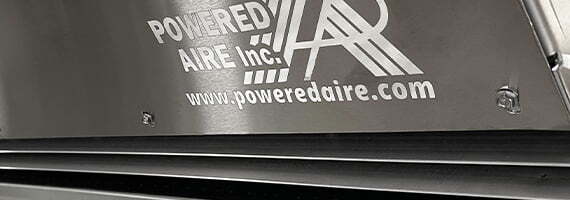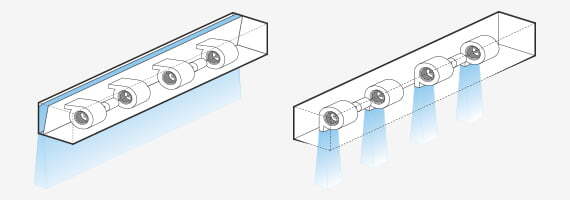
A key element to designing an energy efficient building is mitigating areas susceptible to energy loss. Some of the biggest offenders just happen to be entrance doors, delivery doors, service doors and garage doors. Basically, the main areas of ingress/egress for the people, goods, and services key to a business’ success.
A large portion of the building’s overall energy loss and consumption can be attributed to air infiltration. The US Department of Energy writes in its Building Energy Data Book that: “Air infiltrations (or air leakages) are often caused by unintentional or accidental introduction of outside air into a building through cracks in the building envelope and/or entrance doors. Infiltrations through door openings become quite significant when the doors are used frequently such as in restaurants, retail stores, supermarkets, offices, and hospitals.”
The last thing a business owner will do is turn away paying customers just to save on energy costs, so there must be a way to ensure total accessibility while keeping energy costs in check. This is the value air curtains provide. Air Curtains have a proven track record of providing an invisible seal that keeps the outside elements exactly where they should be-outside. However, incorporating air curtains into the building design is not always as easy as it seems. Fortunately, there are some solutions in this article that will help you choose the right air curtain for your application.
1. Choose a stainless-steel air curtain case - Cabinet material and style play a significant role in the overall aesthetic and longevity of an air curtain. Powered Aire uses 304 stainless-steel with a #3 finish as its standard cabinet material. This is due to stainless-steel having excellent corrosion resistance and durability. Since most air curtains are installed on the building envelope, it is vital that the cabinet withstands local conditions such as humidity and salty, coastal air. Additionally, the durability of 304 stainless steel makes it extremely easy to clean and sanitize. This is crucial for any food service application.

2. Function is key but don’t forget Form - The style of the air curtain cabinet determines not only its visual appearance but how it fits within the space. For commercial applications, Powered Aire offers 4 different variations, each with its own unique purpose.
- Commercial: Powered Aire’s commercial cabinets offer a traditional square design and measure 15”H by 17” deep. They feature beveled edges and a patterned intake screen with perforated holes. They also incorporate Powered Aire’s unique plenum discharge and a variety of motor and control options.
- Low-Profile: Low-profile models include the MP and EVE models. These slimmed down air curtains are ideal for low clearance applications, concession windows, or when a sleeker look is desired. The MP is a shrunken version of the commercial cabinet with beveled edges and a perforated front intake screen. It measures 8.5” in height and 13” in depth. The EVE features rounded lines and a punched hole pattern on the front intake. The EVE measures 8.5” in height and 14.8i” in depth. Both models boast 304 stainless steel cabinets, however the EVE is also offered in white and black finish.
- In-Ceiling: Powered Aire Chameleon models are designed to mount flush with the ceiling. The decorative intake grille provides a hinged access panel and is powder coated white to blend in with the ceiling. The outer edges are folded steel ensuring straight lines against a flat ceiling. Chameleon models include Powered Aire’s plenum discharge, a remote-control panel, and numerous motor and control options.
- Recessed: Commercial and low-profile cabinets can be hidden in a ceiling with the addition of a nozzle extension. Powered Aire offers custom fabricated nozzle extensions made from either 304 stainless-steel or galvanized steel. It is important to note that a return grill will need to be installed nearby for access to the air curtain. The air curtain discharge nozzle should also be installed away from the header wall. Measuring the distance from the top of the door to the ceiling and dividing it by 2 equals the distance the nozzle needs to be pulled away from the wall.
3. Made-to-Spec – A door on one side of the building can have completely different needs than a door on the other side. This is why it’s important to work with an Air Curtain provider that can engineer each air curtain to your specific needs. It’s important to consider a few key advantages when selecting an air curtain.
- Oversized Openings? No opening is too tall or wide. Powered Aire offers air curtains for openings up to 50’ in height and virtually any length. There is no need to piece air curtains together as Powered Aire can supply a single air curtain that operates on a single circuit and a single set of controls. This saves on time, installation costs and resources.
- Single Point Power Connection and Custom Electric Heat: Powered Aire provides branch fusing on electrically heated units that combines the motors and heaters on a single electrical circuit. This reduces the number of circuits that need installed between the buildings electrical panel and the air curtain. For existing buildings with existing electrical panels, Powered Aire will make custom heaters that accommodate the standing breaker size.
- Custom Hot Water & Steam Coils: All hydronic heating coils are made to spec. 2-way and 3-way control valves can also be supplied to further ensure customization
- Smart-Touch Controller: Powered Aire’s Smart-Touch Controller features complete functionality inside a convenient touch-screen interface.

The SmartTouch simplifies air curtain automation
4.Plenum Discharge - To provide the best possible seal, an air curtain needs to span the entire width of an opening and meet the ground with enough controlled airflow to achieve its intended results. What can’t be overlooked is how this airflow is discharged. Most air curtains feature dual-shaft motors with blowers attached to each side. When the blowers directly face the narrow discharge nozzle the resulting airstream is not uniform. Complete holes in airflow exist under the motors, under adjacent blowers, and near the ends of the unit. Powered Aire’s plenum discharge pressurizes a space within the air curtain cabinet creating an exceptionally uniform airstream.
Another added benefit to a plenum discharge is noise reduction. The noise created by an air curtain is not mechanical, it’s created by forcing high volumes of air through a narrow linear discharge nozzle. Powered Aire’s plenum discharge spreads this high-volume air out evenly along the discharge nozzle resulting in noise reduction of up to 3dBA per motor.

To learn more about specifying architectural air curtains into your plans, contact your local HVAC representative and ask them to set up a lunch and learn with Powered Aire where you can get your AIA/PDH credits and learn about a valuable tool to improving efficiency and aesthetics in your buildings. Or, just shoot us a message at info@PoweredAire.com and we’ll get you set up with a rep in your area.
